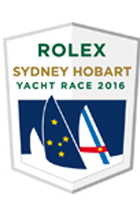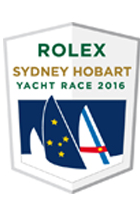Rolex Sydney Hobart Race 2016

The 628-nautical miles of endeavour, drive and determination which underpin each and every edition of the Rolex Sydney Hobart Yacht Race will again come to the fore at this year’s 72nd running of one of the world’s most famous and revered yacht races.
The Rolex Sydney Hobart, organized by the Cruising Yacht Club of Australia (CYCA), has run every year since its inaugural race in 1945. Its rich history, distinctive date and reputation as one of the world’s toughest ocean races have contributed to its status as a genuine icon in the sport.

Rolex has been title sponsor since 2002 and the race forms one of the core events in its annual yachting calendar. A stringent examination of seamanship and a genuine test of human endeavour, this elite competition has, throughout its history, been defined by the pioneering feats and intrepid spirit of adventure of those who participate.
FACT: 5,828 yachts have started the 71 editions of the race. 4,812 have finished the race. The 1,016 yachts that have failed to finish are testament to the race’s true difficulty.
A Public Showcase
The start of the Rolex Sydney Hobart is one of the most viewed sailing events in the world, and arguably the only one that unites an entire nation. On 26 December, Australia is in a festive mood. Just when the traditional international test cricket match in Melbourne breaks for lunch, the starting signal for the Rolex Sydney Hobart is fired, with an estimated one million Australians watching live from one of Sydney Harbour’s many vantage points, on television, or from the water itself.

During the race start, iconic landmarks like the Opera House and Sydney Harbour Bridge pay witness to the action out on the water as a fleet of around one hundred yachts ranging from 100-ft cutting-edge Maxis, crewed by elite professional sailing talent, to 30-ft family-sailed yachts jostle for space at sea.
FACT: The record number of yachts to start a Rolex Sydney Hobart is 371, which marked the 50th edition of the race in 1994.
While the start is a truly public occasion, the race can soon become an isolated experience for those competing. The fleet disperses as the sight of dry land fades. While some crews have other yachts for company, many will sail alone without a competitor in sight. The race is a true test of resources, notably for those out at sea the longest, whose main goal is to finish before the year ends. Crews manage carefully planned watch-systems to ensure energy levels are sustained. The race is demanding both physically and mentally, with continual tactical and navigational decisions required.

The famous 628-nm racecourse takes the fleet south along the New South Wales coast of the Tasman Sea before crossing the eastern edge of Bass Strait, and continuing down the east coast of Tasmania before the final, sometimes frustratingly slow, leg up the Derwent River to the historic port of Hobart. Competitors must be prepared for all kinds of conditions, often within the same race.
This is a punishing contest where the elements can escalate dramatically and, on occasions, be unforgiving. The 1998 edition of the race witnessed severe storms, the sinking of five yachts and the loss of six lives in Bass Strait. The organizers’ response was pro-active: new safety measures and regulations were introduced immediately after the disaster and given their global resonance were adopted around the world.
FACT: Six yachts – Rani (1945), American Eagle (1972), Kialoa II (1977), New Zealand (1980), Sovereign (1987), Wild Oats XI (2005, 2012) – have done the double, achieving the momentous feat of winning line honours and the Tattersall’s Cup in the same year.
Constant Challenges
The one thing all crews can be assured of is a warm welcome when reaching Hobart. The arrival of the first yacht is always a significant occasion, of great media and public interest. In the modern era of the race, one yacht - the late Bob Oatley’s 100-ft Maxi Wild Oats XI - has dominated line honours, finishing fastest in eight of the last eleven races.
For the past two years, Wild Oats XI has had to contend with fierce competition, notably in the shape of Jim Clark and Kristy Hinze Clark’s Comanche. This sporting rivalry between two of the world’s most powerful 100-ft Maxis added an extra layer of intrigue to an already fascinating race. Wild Oats XI prevailed over the then newly-launched American yacht in 2014. A year later Comanche claimed line honours as Wild Oats XI suffered a torn mainsail and was forced to retire during the first night at sea.

Wild Oats XI, skippered to all her successes by Mark Richards, will seek a return to glory and a ninth line honours title in 2016.
FACT: Wild Oats XI has twice set the race record at the Rolex Sydney Hobart. In 2012 she set the current benchmark time of 1 day, 18 hours, 23 minutes and 12 seconds. The race record has been broken eleven times in the race’s history.
Making History
Finishing first is not the most sought-after prize at the Rolex Sydney Hobart. It plays second to claiming the famous Tattersall’s Cup and Rolex timepiece as overall winner on handicap. The reason is simple, win this race and you instantly become part of sailing legend.
The handicap system is a democratic one, ensuring the target of victory is theoretically open to any boat in the fleet. The weather conditions play their part. How crews manage the race collectively, tactically and navigationally is even more important. The roll of honour over seventy years of the race demonstrates the rich variety of yachts to have won. Over the past decade alone, ten different yachts have triumphed, ranging from 40–100 feet.
Last year’s winner was the 52-foot Balance. Defending this title will prove a difficult feat for Paul Clitheroe and his crew. The last yacht to win back-to-back races was Freya over fifty years ago. A clear sign of both the race’s unpredictability and its stringent demands on those competing.

FACT: The first winner of the race was the 30-ft Rani, sailed by British Captain John Illingworth, one of the race’s founding-fathers. Rani finished in six days, 14 hours, 22 minutes, arriving on the evening of New Year’s Day 1946.
Driven to Compete
This is a race all sailors want etched on their résumé. Completing the Rolex Sydney Hobart Yacht Race is a notable achievement. For many competitors, once they have finished their first race it becomes a genuine passion, almost an obsession. Characters like Tony Cable who has sailed the race on fifty occasions; Sean Langman who has skippered among the largest, fastest yachts in the fleet and now helms one of the smallest; Syd Fischer who raced 47 times as a skipper; Adrienne Calahan, the world-renowned female sailor who has competed most times, are typical of the personalities who demonstrate the everlasting allure of this famous race.

Internationally the race’s appeal is vast with yachts frequently representing countries from Asia, Europe and the United States and significant media coverage across the globe.
FACT: The last overseas winner of the Rolex Sydney Hobart was Roger Sturgeon’s Rosebud from the United States in 2007.
A Path to Glory
The race has always held a magnetic appeal, attracting not only sailors of all backgrounds but politicians, business leaders and stars from other sports. Succeeding at the Rolex Sydney Hobart Yacht Race demands many qualities – excellent seamanship, effective teamwork, tactical guile and a desire to push the limits. Competitors must respect the elements, act quickly under pressure and overcome the constant challenges they face. This drive for excellence and pursuit of glory are qualities shared with title sponsor Rolex.

The 2016 Rolex Sydney Hobart Yacht Race will start on Monday 26 December at 13:00 (AEDT).
Rolex & Yachting
Rolex has always sought to associate with activities that, like itself, were motivated by passion, excellence, precision and team spirit. Naturally, Rolex gravitated toward the elite world of sailing, forming an alliance that dates back to the late 1950s. Today, Rolex is Title Sponsor of some 15 major international events such as the Rolex Sydney Hobart and the biennial Rolex Fastnet Race, through to the highest-level one-design competition at the Rolex Farr 40 World Championship, spectacular gatherings at the Maxi Yacht Rolex Cup and the Rolex Swan Cup, as well as the brand’s support of the International Sailing Federation.
Its close relationships with the most prestigious yacht clubs around the world, including the New York Yacht Club (US) and the Royal Yacht Squadron (Cowes, UK), Rolex is driven by a passion for excellence and a great appreciation for yachting that furthers the strong ties that bind these two worlds in their shared pursuit of perfection.
About Rolex
Leading brand of the Swiss watch industry, Rolex, headquartered in Geneva, enjoys an unrivalled reputation for quality and expertise the world over. Its Oyster watches, all certified as chronometers for their precision, are symbols of excellence, performance and prestige. Pioneer in the development of the wristwatch as early as 1905, the brand is at the origin of numerous major watchmaking innovations, such as the Oyster, the first waterproof wristwatch, launched in 1926, and the Perpetual rotor self-winding mechanism, introduced in 1931. Rolex has registered over 400 patents in the course of its history.
A truly integrated and independent manufacturing company, Rolex designs, develops and produces in-house all the essential components of its watches, from the casting of the gold alloys to the machining, crafting, assembly and finishing of the movement, case, dial and bracelet. Rolex is also actively involved in supporting the arts, sports, exploration, the spirit of enterprise, and the environment through a broad palette of sponsoring activities, as well as philanthropic programmes.
*Images courtesy of Rolex Sydney Hobart Yacht Race


Post your comment
You cannot post comments until you have logged in.
Login to post a commentComments
No one has commented on this page yet.
RSS feed for comments on this page | RSS feed for all comments